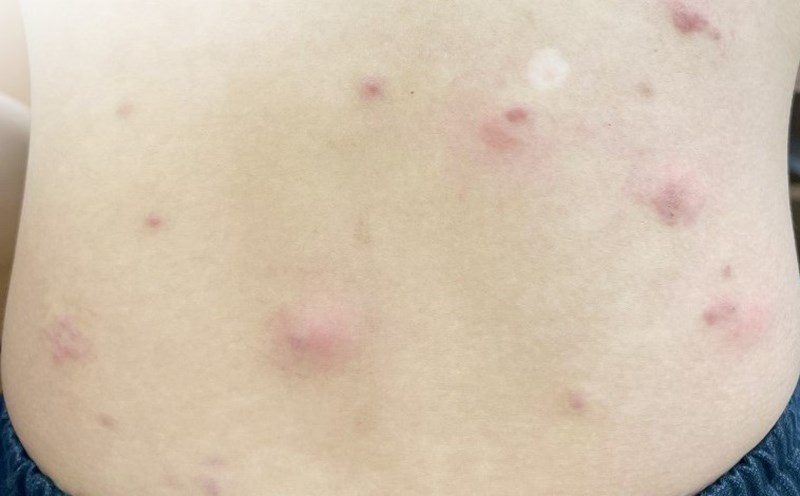Discovering mobile phlegm under the skin
Ms. N.L (65 years old, Quang Ninh) was hospitalized for severe abdominal pain, continuous diarrhea and itchy skin that lasted for more than a month. Tests showed that she was infected with worms that stabbed dogs and cats and large liver failure, possibly due to contact with domestically raised dogs. Previously, she had a history of high blood pressure and had been treated at a local hospital but the disease recurred. The patient had diarrhea up to 25-26 times/day, on the skin there were itchy patches and round rows - signs of parasites moving under the skin.
Mrs. L's family raised a 25kg dog that had vomited and was uncomfortable but was not noticed. Direct exposure to dogs without protective measures can be the cause of her parasitic infection. Tests at the Central Hospital for Tropical Diseases showed that she was positive for large liver failure and cat-and- dog worms, with an IgE index 16 times higher than normal. After a week of treatment, her health was stable, she continued outpatient treatment and a follow-up for 6 months to avoid reinfection.
A 42-year-old female patient in Vinh Phuc was hospitalized for itching all over her body, especially with a long, wheezing groin on her hand, 5cm bulging. The test determined that the patient tested positive for toxocara spp. The patient works as a farmer, raising 3 dogs and 5 cats. After treatment, the itching disappeared, and the scar immediately appeared. The patient was discharged from the hospital and scheduled to return for a follow-up examination after one month to assess the severity of the infection and continue treatment if necessary.
The 48-year-old male patient in Hoa Binh City has the habit of eating fish salad, raw vegetables and raising dogs. In October 2024, he showed symptoms of itching and rough skin, and was diagnosed with allergic dermatitis. However, when he scaled on his left knee, he discovered a 10-15cm long white line, thought to be a tendon, so he cut it off.
After going to Hoa Binh General Hospital and transferring to Dang Van Ngu Hospital (Hanoi), the patient was confirmed to be infected with dragon worms. On February 25, CDC Hoa Binh coordinated to monitor the case. Currently, the scar has healed, the patient is continuing to be monitored and instructed to remove worms from the body safely.

Increased pet infections in Vietnam
Dr. Hoang Dinh Canh - Director of the National Institute of Parasitic and insect Malaria - said that statistics in 2024 show that among the parasitic diseases coming to Dang Van Ngu Hospital for examination, the most are worm larvae that attack dogs, with more than 19,500 examinations, an increase of more than 25%.Similarly, there were more than 2,200 examinations for dog rhinitis, an increase of more than 174%, for thornyhead worm disease with 156 examinations, an increase of 105%.
In the first 2 months of 2025, the hospital received 22 cases of pig-lyceous Larvae infections, 17 cases of large liver disease, 1 case of lung disease, 4 cases of eel worms, 1 case of small liver disease, 11 cases of rat rat rat rat disease.Vietnam currently has about 10 types of diseases caused by parasites, of which worms transmitted through soil are one of the silent but persistent threats to public health.
The rate of earth-permitted worm infection nationwide is estimated at about 30%, with the highest common rate in the Northern mountainous region and the Central Highlands (50-84%).The Central and Central Highlands provinces have a ratio of 30-50%, while the Red River Delta is 10-30%, and the lowest is the Southern provinces with about 5-20%.High-risk groups include preschool children, students, and women of reproductive age.
In addition to earthworms, many other parasitic diseases are on the rise but have not received due attention. One of them is worm disease that stabs dogs and cats - a consequence of raising pets but not controlling hygiene well.
Jade worms infect dogs and cats through animal feces, can enter the body through the mouth when in contact with pet dander, hugging animals or gardening without protection. Once in the body, the worm Larvae can move to the blood, lungs, liver, and eyes, causing dangerous complications.
Children are susceptible to disease by playing with sandy soil containing worm eggs. People who hug or sleep with their pet are at high risk of prolonged itching, pneumonia, liver damage, impaired vision, and even encephalitis. In addition to worms and spurs, pets can also transmit rabies, Pasteurella infection, Leptospira...
Doctors recommend periodically exfoliating dogs and cats, keeping the environment hygienic, and wearing gloves when cleaning stools to limit the risk of infection.











